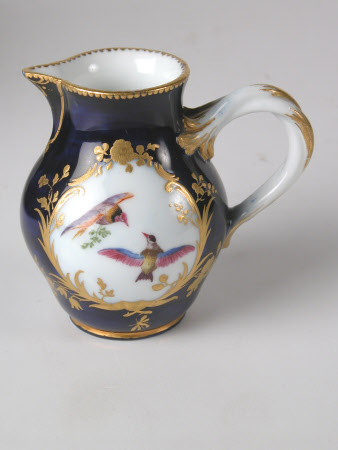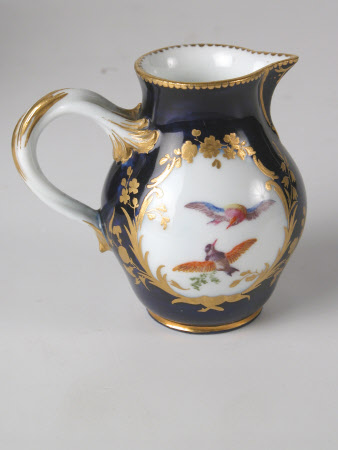Cream jug
Sèvres Porcelain Manufactory
Category
Ceramics
Date
1756 - 1757
Materials
Soft-paste porcelain, underglaze cobalt blue, polychrome enamels, gold
Measurements
75 x 80 x 55 mm
Place of origin
Sèvres
Order this imageCollection
Osterley Park and House, London
NT 771404.2
Summary
A jug, or pot à lait Hébert with entwined foliate handles, for cream, part of a Sevres déjeuner with bleu lapis ground, the panels painted in colours with birds within gilt flowering foliage cartouches.
Full description
At Osterley Park, the mansion house remodelled by Robert Adam for the Child family from 1761, there is a collection of French porcelain déjeuners, matched sets of items associated with drinking hot beverages at breakfast. These were objects enjoyed in the intimacy of the boudoir as part of the toilette and, unlike costly table services, were affordable, if expensive, luxuries that were acquired by the English aristocracy. They were made at the manufactory first established at the château de Vincennes, east of Paris, in 1740, which in 1756 moved to Sèvres to be closer to the court at Versailles and in particular to Madame de Pompadour, Louis VV’s mistress and its leading patron. Sèvres became the royal manufactory when it was purchased outright by the king in 1759. Déjeuners, still a novelty in 1756–7, varied greatly in shape and form. The Osterley tray of triangular or more properly hexafoil shape perhaps resembled one used in the ‘déjeuner triangle’ sold by Duvaux in 1755. The form was adapted from the plateau Bouret, introduced as a stand for ice-cream cups in the celebrated service made for Louis XV between 1753 and 1754. The tray is accompanied by a ‘pot à sucre Calabre’ for sugar, a ‘pot à lait Hébert’ with entwined foliate handles, for cream, and a small ‘tasse à toilette et soucoupe’, the last two missing covers. The shape names ‘Bouret’, ‘Calabre’ and ‘Hébert’ are those of shareholders in the manufactory when it was a private company. The colourful birds were executed by three different painters, many formerly fanpainters. There are also variations in the gold details added by the gilders, who did not apply personal marks until the 1770s. The Osterley déjeuner includes no pots for coffee or chocolate since its purchaser probably already owned ones made of silver or copper. Much of the French porcelain at Osterley is recorded in an 1867 inventory of the banking family’s townhouse on Berkeley Square, which they had owned since 1767. Francis Child III (1735–63), who came into his fortune just before the Seven Years’ War discouraged French travel, may have bought it. His brother Robert Child (1739–82) acquired Sèvres porcelain at an auction in 1772, sold by the china dealer Thomas Morgan of Arlington Street. Robert’s widow, Sarah (c.1740–93), identified as ‘Mrs. Childs’, was a buyer at a Christie’s auction of ‘Seve Porcelain’ on 15–16 March 1790, perhaps the distressed sale of an early émigré, who had fled the revolution in France. However, the items at Osterley that match the descriptions of these purchases are dated 1779–83, and so the sales do not account for the presence of the earlier wares described here. Text adapted from Patricia F. Ferguson, Ceramics: 400 Years of British Collecting in 100 Masterpieces, Philip Wilson Publishers, 2016.
Provenance
Part of the Jersey bequest, March 1993
Marks and inscriptions
The factory mark, enclosing the date letter ‘D’ for 1757 above the painter’s mark of a sword for Étienne Evans in blue enamel on all,except the sugar bowl, which has the unidentified painter’s mark of a lozenge in blue enamel, and the saucer, which has the factory mark in underglaze cobalt blue, enclosing the date letter ‘C’, surrounded by the painter’s mark of four dots and a pair of callipers for Mutel, in blue enamel.
Makers and roles
Sèvres Porcelain Manufactory , manufacturer
References
Ferguson 2016: Patricia F. Ferguson, Ceramics: 400 Years of British Collecting in 100 Masterpieces, Philip Wilson Publishers, 2016, pp. 98-9




